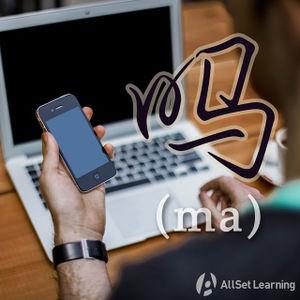Difference between revisions of "Yes-no questions with "ma""
m (Text replacement - "zùo" to "zuò") |
|||
| Line 1: | Line 1: | ||
{{Grammar Box}} | {{Grammar Box}} | ||
| − | The question particle 吗 (ma) is a | + | The question particle 吗 (ma) is a simple way to form questions in Chinese. By placing 吗 (ma) on the end of a statement, you convert it into a ''yes/no question'', (questions that could be answered with ''yes'' or ''no'' in English.) They're also known as ''polar questions''. |
== Basic Usage == | == Basic Usage == | ||
| Line 14: | Line 14: | ||
</div> | </div> | ||
| − | + | === Examples === | |
<div class="liju"> | <div class="liju"> | ||
| Line 29: | Line 29: | ||
</div> | </div> | ||
| − | |||
| − | |||
More examples of statements and their yes/no question forms: | More examples of statements and their yes/no question forms: | ||
| Line 79: | Line 77: | ||
</div> | </div> | ||
| − | These would be something like " | + | These would be something like "Are you who are you?" and "Is this is a book?" in English--both obviously wrong. Still, if you're not careful, you may find yourself throwing a 吗 (ma) onto the end of a question that doesn't need it. Many learners make this mistake, so don't worry if it happens every once in a while, just catch it and remember it the next time. |
== More Advanced Usage == | == More Advanced Usage == | ||
Revision as of 07:43, 24 June 2015
-
Level
-
Similar to
-
Used for
-
Keywords
The question particle 吗 (ma) is a simple way to form questions in Chinese. By placing 吗 (ma) on the end of a statement, you convert it into a yes/no question, (questions that could be answered with yes or no in English.) They're also known as polar questions.
Contents
Basic Usage
Structure
Any statement can be converted into a yes / no question with 吗 (ma). You could think of 吗 (ma) as being like a question mark you say out loud. So the basic structure is:
statement sentence + 吗 ?
Examples
- 你 喜欢 咖啡 。 (statement)You like coffee.
"You like coffee" can easily be converted into "Do you like coffee?" by adding 吗 (ma):
- 你 喜欢 咖啡 吗? (question)Do you like coffee?
More examples of statements and their yes/no question forms:
- 你 去 。 (statement) You go.
- 你 去 吗 ? (question)Are you going?
- 你 喝 茶 。 (statement)You drink tea.
- 你 喝 茶 吗 ? (question)Do you drink tea?
- 你 学 中文 。 (statement) You study Chinese.
- 你 学 中文 吗 ? (question) Do you study Chinese?
- 他 是 老师 。 (statement)He is a teacher.
- 他 是 老师 吗 ? (question)Is he a teacher?
- 你 是 学生 。 (statement)You are a student.
- 你 是 学生 吗 ? (question)Are you a student?
- 你 是 医生 。 (statement)You are a doctor.
- 你 是 医生 吗 ? (question)Are you a doctor?
- 那 是 老虎 。 (statement)That is a tiger.
- 那 是 老虎 吗 ? (question) Is that a tiger?
- 你 认识 我 。 (statement)You know me.
- 你 认识 我 吗 ? (question)Do you know me?
- 你 会 做 饭 。 (statement)You know how to cook.
- 你 会 做 饭 吗 ? (question) Do you know how to cook?
- 你 想 家 。 (statement)You miss home.
- 你 想 家 吗 ? (question)Do you miss home?
It's important to remember that you do not normally add 吗 (ma) to a sentence that's already a question. For example:
- 你 是 谁 吗?(谁 is a question word)
- 这 是 不 是 书 吗?(是不是 is a question pattern)
These would be something like "Are you who are you?" and "Is this is a book?" in English--both obviously wrong. Still, if you're not careful, you may find yourself throwing a 吗 (ma) onto the end of a question that doesn't need it. Many learners make this mistake, so don't worry if it happens every once in a while, just catch it and remember it the next time.
More Advanced Usage
However, this doesn't mean that a sentence can't ever have a question word and 吗 (ma). If a sentence contains verbs of understanding such as "知道 (zhīdao),了解 (liǎojié), 明白 (míngbai), 认识 (rènshi)" etc, then "吗" (ma) can still be added at the end of the question.
This is not a necessary pattern for a beginner to know, but you may also wish to read about advanced yes-no questions with "ma".
See also
Sources and further reading
Videos
- Yoyo Chinese: Yes-no Questions with 吗
Books
- Chinese: An Essential Grammar, Second Edition (pp. 138-40) →buy
- Integrated Chinese: Level 1, Part 1 (3rd ed) (pp. 29-30) →buy
- New Practical Chinese Reader 1 (新实用汉语课本1) (p. 21) →buy
- New Practical Chinese Reader 1 (新实用汉语课本1)(2nd ed) (pp. 23, 250) →buy



